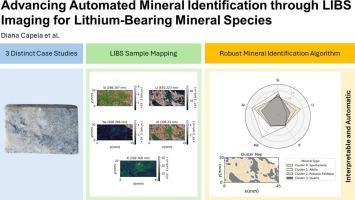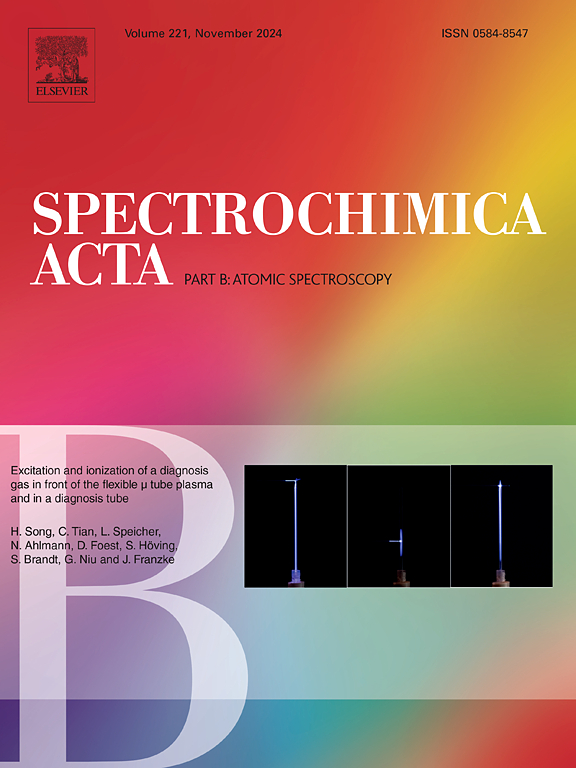利用LIBS成像技术推进含锂矿物的自动识别
IF 3.2
2区 化学
Q1 SPECTROSCOPY
引用次数: 0
摘要
在地质科学中,矿物鉴定是一项具有挑战性的任务,通常需要对样品的物理和化学性质进行多次分析才能得到准确的结果。这项任务对于采矿业来说尤其重要,在采矿业中,适当和快速的矿物识别可能会转化为重大的效率和性能提升,例如锂采矿业。在本研究中,利用激光诱导击穿光谱(LIBS)成像对一种矿物识别算法进行了优化,并对一组具有代表性的样品进行了测试。该算法结合了先进的光谱处理技术-基线去除,高斯滤波和数据归一化-以及无监督聚类,以生成可解释的分类图和辅助图表。这些改进有助于快速和精确地标记矿物成分,显著提高用户界面的可解释性和交互性。在不同复杂程度的矿物样品上进行的大量测试证实了该算法的鲁棒性和广泛的适用性。指出了与样品粒度测定和LIBS分辨率相关的挑战,提出了优化系统分辨率以提高复杂矿物基质分类精度的未来方向。将这种先进的算法与LIBS技术相结合,有可能加速矿物评价,为更有效和可持续的矿物勘探铺平道路。本文章由计算机程序翻译,如有差异,请以英文原文为准。

Advancing automated mineral identification through LIBS imaging for lithium-bearing mineral species
Mineral identification is a challenging task in geological sciences, which often implies multiple analyses of the physical and chemical properties of the samples for an accurate result. This task is particularly critical for the mining industry, where proper and fast mineral identification may translate into major efficiency and performance gains, such as in the case of the lithium mining industry. In this study, a mineral identification algorithm optimized for analyzing lithium-bearing samples using Laser-induced breakdown spectroscopy (LIBS) imaging, is put to the test with a set of representative samples. The algorithm incorporates advanced spectral processing techniques—baseline removal, Gaussian filtering, and data normalization—alongside unsupervised clustering to generate interpretable classification maps and auxiliary charts. These enhancements facilitate rapid and precise labelling of mineral compositions, significantly improving the interpretability and interactivity of the user interface. Extensive testing on diverse mineral samples with varying complexities confirmed the algorithm's robustness and broad applicability. Challenges related to sample granulometry and LIBS resolution were identified, suggesting future directions for optimizing system resolution to enhance classification accuracy in complex mineral matrices. The integration of this advanced algorithm with LIBS technology holds the potential to accelerate the mineral evaluation, paving the way for more efficient and sustainable mineral exploration.
求助全文
通过发布文献求助,成功后即可免费获取论文全文。
去求助
来源期刊
CiteScore
6.10
自引率
12.10%
发文量
173
审稿时长
81 days
期刊介绍:
Spectrochimica Acta Part B: Atomic Spectroscopy, is intended for the rapid publication of both original work and reviews in the following fields:
Atomic Emission (AES), Atomic Absorption (AAS) and Atomic Fluorescence (AFS) spectroscopy;
Mass Spectrometry (MS) for inorganic analysis covering Spark Source (SS-MS), Inductively Coupled Plasma (ICP-MS), Glow Discharge (GD-MS), and Secondary Ion Mass Spectrometry (SIMS).
Laser induced atomic spectroscopy for inorganic analysis, including non-linear optical laser spectroscopy, covering Laser Enhanced Ionization (LEI), Laser Induced Fluorescence (LIF), Resonance Ionization Spectroscopy (RIS) and Resonance Ionization Mass Spectrometry (RIMS); Laser Induced Breakdown Spectroscopy (LIBS); Cavity Ringdown Spectroscopy (CRDS), Laser Ablation Inductively Coupled Plasma Atomic Emission Spectroscopy (LA-ICP-AES) and Laser Ablation Inductively Coupled Plasma Mass Spectrometry (LA-ICP-MS).
X-ray spectrometry, X-ray Optics and Microanalysis, including X-ray fluorescence spectrometry (XRF) and related techniques, in particular Total-reflection X-ray Fluorescence Spectrometry (TXRF), and Synchrotron Radiation-excited Total reflection XRF (SR-TXRF).
Manuscripts dealing with (i) fundamentals, (ii) methodology development, (iii)instrumentation, and (iv) applications, can be submitted for publication.

 求助内容:
求助内容: 应助结果提醒方式:
应助结果提醒方式:


